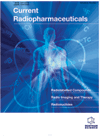- Home
- A-Z Publications
- Current Radiopharmaceuticals
- Previous Issues
- Volume 15, Issue 4, 2022
Current Radiopharmaceuticals - Volume 15, Issue 4, 2022
Volume 15, Issue 4, 2022
-
-
Methodological Aspects and the Prognostic Value of Metabolic Tumor Volume assessed with 18F-FDG PET/CT in Lymphomas
More LessAlthough metabolic tumor volume (MTV) assessed with pretreatment 18F-FDG PET/CT has shown significant prognostic value across many lymphoma types, it is still not used in clinical practice due to technical concerns and the lack of standardisation. Numerous studies on the prognostic value of MTV in lymphomas have been published in recent years, but there is still no full agreement on the best methodology Read More
-
-
-
Discovery and Design of Radiopharmaceuticals by In silico Methods
More LessAuthors: Maryam Salahinejad, David A. Winkler and Fereshteh ShiriThere has been impressive growth in the use of radiopharmaceuticals for therapy, selective toxic payload delivery, and noninvasive diagnostic imaging of disease. The increasing timeframes and costs involved in the discovery and development of new radiopharmaceuticals have driven the development of more efficient strategies for this process. Computer-Aided Drug Design (CADD) methods and Machine Learning (ML) hav Read More
-
-
-
Assessment of Radiation Exposure Dose for Nuclear Medicine Workers from 18F-FDG, 99mTc MDP, and 99mTc
More LessBackground: Nuclear medicine or diagnostic radiology personnel are always exposed to low-level radiation from radionuclides used in medical diagnostics, which lead to potential biological hazards or effects. Objective: External exposure for workers in two nuclear medicine centers was measured by recruiting 120 patients. Methods: Three nuclear medicine examinations were performed using F18-FDG PET/CT,99mTc- MD Read More
-
-
-
Assessment of Knowledge and Level of Radiation Safety Awareness among Radiographers Working in Nuclear Medicine
More LessBackground: Radiopharmaceuticals are used for the diagnosis, treatment, staging, and follow- up of various diseases. However, there is concern that the ionizing radiation (gamma rays, α and ß particles) may result in the exposure of radiographers with limited knowledge of the principles of radiation protection and safety, raising the risk of cancer induction. Objective: The aim of the study is to investigate the knowledge and l Read More
-
-
-
Effect of Nano-Curcumin on Radiotherapy-Induced Skin Reaction in Breast Cancer Patients: A Randomized, Triple-Blind, Placebo-Controlled Trial
More LessPurpose: Despite advances in medical technology, radiation-induced dermatitis occurs in 95% of cancer patients receiving radiation therapy. Currently, there is no standard and effective treatment for the prevention or control of radiation dermatitis. The aim of this study was to determine the efficacy of nano-curcumin in alleviating the radiation-induced skin reactions (RISRs) in breast cancer patients. Methods: A randomize Read More
-
-
-
Fully Automated Methods for [18F]FDG and [18F]-NaF Productions Using Explora FDG4: Validation and Reliability of Multi-subsequent Preparations for Clinical Applications
More LessAuthors: Eman Awad, Hatim Ali, James Lamb and Ehab Al-MomaniBackground: The worldwide usage of [18F]-sodium fluoride in clinical applications has increased the interest in the facility of its production. The development of a new automated method for multi-preparations of [18F]-NaF and [18F]FDG on an Explora FDG4 module is described. Explora FDG4 is one of the most widely used synthesizers for FDG production in daily routine use and is specifically designed to run up to four different Read More
-
Volumes & issues
Most Read This Month
Article
content/journals/crp
Journal
10
5
false
en


